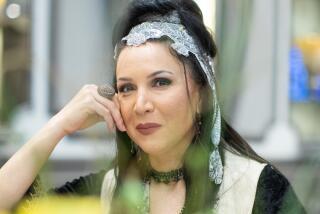A beautiful ‘Princess’ tells a story
- Share via
A 17th century Iranian folk tale and Central Asian dance traditions shape an unusual family offering at the outdoor John Anson Ford Amphitheatre this week. Filled with fairies, monsters, magic and a plucky royal heroine, the Gulistan Dance Theater’s production of “Princess Firuza and the Horse Prince” is an exotic part of the Ford’s summer family series, “Big!World! Fun!: Stories From Around the World.”
Known for its renditions of the classical and folkloric dance and music traditions of Iran, Tajikistan and Uzbekistan, the 16-member ensemble, led by artistic director Carolyn Krueger, uses dance, music, theatrical action and narration to tell the story of a princess who disguises herself as a boy and sets out on horseback to rescue her father, the king of Iran.
As it turns out, he’s been turned into a pebble by a demon monster, and the princess, with help from her magic horse and a wise woman, must break the spell.
Krueger’s company usually performs for adults, but she has tailored this fantasy-laden show for children ages 4 to 11. It unfurls Saturday at 10 a.m.
“There’s just so much for the senses -- the colors and textures, the sounds the dancers make with bells -- that I’ve found it highly accessible to almost all audiences,” she said, “and I’ve chosen the music carefully to be appealing to a first-time listener.”
Krueger has adapted the dances in the show from a variety of sources. They include an Arabic “river dance,” a flowing “canopy dance” representing different cultural aspects of Iran and an “animal dance” that comes from Afghanistan. A mountain “Dev” -- a monster in the story -- “does a tribal dance taken from the plains of Iran,” she said.
Masks and jewel-toned, 17th century-style costumes provide visual interest, along with silks and other fabrics that serve as scenery, including a garden represented by a length of embroidery in traditional Bukhara style with stylized plant motifs.
“It’s very ornamental looking,” Krueger said, “but the internal experience is just as important as the outward. I would say in a lot of Western dance all the energy is externalized into big movements, whereas in Eastern dance and Uzbek dance, there’s an internalization of energy and movement that can be very subtle but very powerful.”
Despite its exotic setting, this 17th century Iranian tale won’t be entirely unfamiliar to fairy tale fans. Its happy ending, for instance, includes an enchantment broken by a kiss.
“I think that through sharing stories and dancing and music from other cultures, we can see how much we all share as human beings,” Krueger said, “the same fears and desires and joys and sorrows.”
*
-- Lynne Heffley
More to Read
The biggest entertainment stories
Get our big stories about Hollywood, film, television, music, arts, culture and more right in your inbox as soon as they publish.
You may occasionally receive promotional content from the Los Angeles Times.










